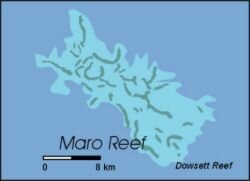Maro Reef is the largest coral reef in the Northwestern Hawaiian Islands (NWHI), with over 1,934 square kilometers (approximately 746 square miles or 478,000 acres) of reef area. Unlike classic ring-shaped atolls, Maro is a complex maze of linear reefs that radiate out from the center like the spokes of a wheel. It is named after the whaling ship Maro, which traveled these waters in 1820.

Marine habitats of Maro Reef range from sandy lagoons to steep reef slopes, large coral heads, ocean pinnacles, and patch reefs. Gaps in the reef cause waves to sweep into the lagoon clouding some areas with silt and sand.
Maro Reef is very large and hard to navigate, making it difficult for scientists to study. It has a greater abundance and diversity of coral than any other reef system in the NWHI chain. Many areas of the reef, particularly on the west side, have a large number of coral species, including Montipora capitata and Porites compressa. Maro Reef has a large amount of the hard, pink crusty algae that grows on coral called "coralline algae" that acts like cement and holds the coral together in high surf. The reefs support numerous butterflyfish and surgeonfish species. Large ulua (jack) and çömilu (bluefin trevally) have been seen in the reef's open waters, along with white-tip sharls and gray reef sharks.
Some researchers believe that, while Maro Reef has very healthy reefs, it may be "on the verge of drowning" because the reefs are narrow, unconnected, and unprotected from storm waves. Others feel that the health of the corals suggest that Maro Reef is a complicated reef system on a large seamount, living in balance with the elements.
|

